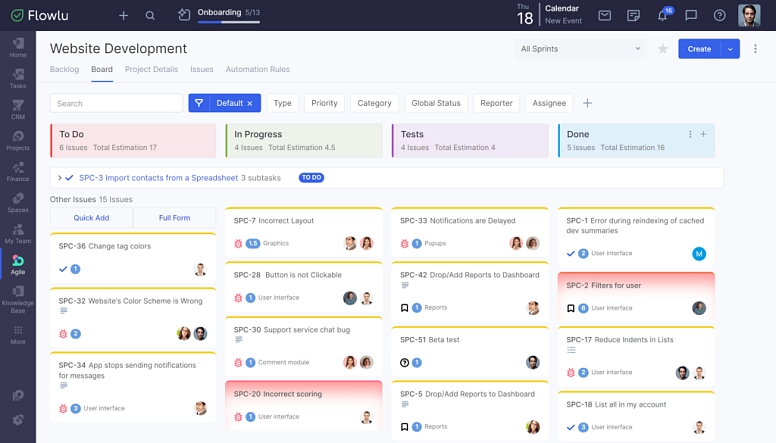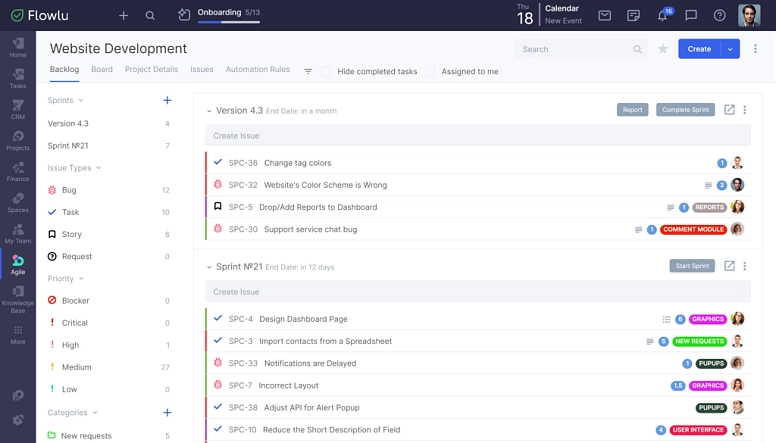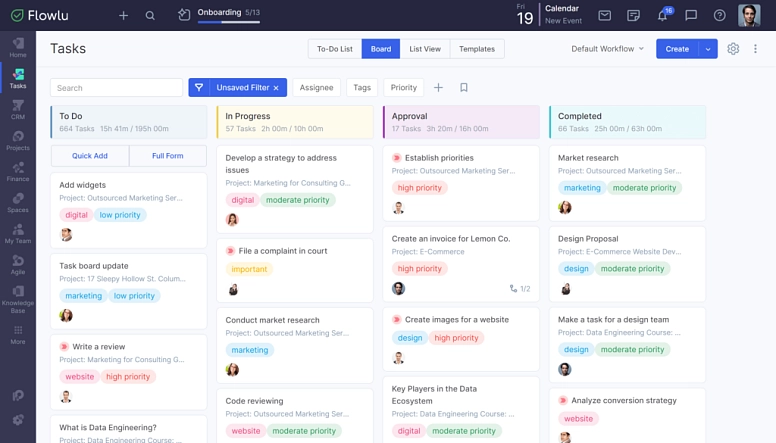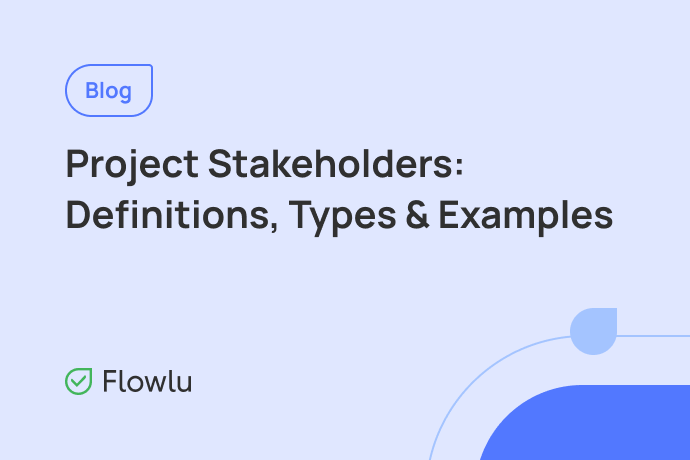Como escolher uma metodologia de gestão de projectos
Como um gerente de projeto, a primeira coisa que você enfrenta ao começar a gerenciar um novo projeto é o problema de escolher uma Metodologia de Gerenciamento de Projetos. Desde o início, sua equipe pode não saber nem por onde começar, e a razão para isso é a ausência de um objetivo claro e a incapacidade de atribuir funções. É por isso que as pessoas começaram a desenvolver Metodologias de Gerenciamento de Projetos, ou PMM.
Neste artigo, vamos guiá-lo pela definição de uma metodologia de gerenciamento de projetos, seus benefícios, estruturas e algumas dicas sobre como escolher e implementá-la em seu negócio.
O que é Metodologia de Gerenciamento de Projetos (PMM)
A Metodologia de Gerenciamento de Projetos (PMM) é um conjunto de princípios e padrões fundamentais para a implementação de projetos. Simplificando, a PMM deve abranger a maneira como você trabalha e a forma como sua equipe se comunica entre si. Todas as PMMs são diferentes, mas todas têm uma coisa em comum — ajudam você a gerenciar seu projeto da forma mais eficaz possível.
Algumas PMMs são bastante antigas, algumas são usadas em campos específicos, mas, de qualquer forma, escolher a certa é quase metade do sucesso de qualquer projeto.
Benefícios de Usar Metodologias de Gerenciamento de Projetos
Um fluxo de trabalho sem princípios e metodologia é um caos. Imagine se sua equipe não soubesse como se comunicar entre si e como se concentrar em suas tarefas. Parece uma bagunça completa, certo? Para evitar tais situações, foram criadas Metodologias de Gerenciamento de Projetos.
Há uma percepção de que as PMMs funcionam bem apenas para projetos de TI, mas achamos que essa percepção está errada. Aqui estão alguns benefícios que mostram que as PMMs podem ser úteis para qualquer projeto:
- Cada membro da equipe saberá seu papel. É fácil gerenciar sua equipe e mantê-los motivados quando todos sabem o que fazer.
- Você pode considerar riscos potenciais. Ao criar um plano, não há problema em reservar algum tempo se algo der errado.
- Uma metodologia definida pode ajudar sua equipe a lidar com suas tarefas de forma mais eficiente e desenvolver suas habilidades. A maioria das metodologias implica insights específicos, então sua equipe precisa aprender algo novo antes de começar a usar qualquer uma das PMMs.
- A metodologia pode ajudar você a fazer um plano abrangente de fluxo de trabalho. Como quase toda metodologia exige cronogramas definidos, você precisa calcular cada etapa. É um processo complicado, mas sem dor — sem ganho!
Dicas para Escolher a PMM Certa para Sua Equipe
Você decidiu que sua equipe precisa de uma Metodologia de Gerenciamento de Projetos, então o que vem a seguir? Como foi dito anteriormente, todas as PMMs são diferentes, então você precisa escolher a apropriada para sua equipe. Se você nunca ouviu falar sobre essas metodologias, aqui estão algumas perguntas que o ajudarão a descobrir que tipo de metodologia você precisa:
Qual é o objetivo do projeto?
A melhor metodologia é aquela que ajuda você a alcançar o objetivo principal. Se você já tem um objetivo definido, é melhor escolher uma metodologia rigorosa, que o levará a ele passo a passo. Mas e se seu objetivo final for abstrato? Nesse caso, é melhor escolher uma metodologia mais flexível para ter a oportunidade de mudar algo no processo de trabalho. Além disso, uma metodologia flexível pode ajudar você a descobrir como seu resultado final deve ser, caso ainda não esteja decidido.
Em que sua equipe está focando?
O próximo passo é entender as necessidades da sua equipe. Com o que você está trabalhando? É TI ou talvez um projeto de marketing? Você está focando no objetivo principal ou em pequenas tarefas? Sua equipe trabalha junta ou prefere realizar suas próprias tarefas? Cada equipe é diferente e tem seus valores, então a decisão final deve se basear no que sua equipe está focando.
Qual PMM você está usando agora?
Usar Metodologias de Gerenciamento de Projetos é uma parte comum do fluxo de trabalho de um projeto hoje em dia, mas e se você já estiver usando uma estrutura e não conseguir alcançar resultados específicos? Ou e se sua equipe não estiver satisfeita com suas tarefas ou ritmo de trabalho?
Quando você sente que algo está errado — realmente está, e todo o plano de trabalho precisa ser mudado. Por exemplo, se sua equipe não consegue lidar com todas as suas tarefas porque a situação do seu projeto muda todos os dias, por que não escolher uma metodologia mais flexível? Experimente outra estrutura ou até tente fazer um híbrido de algumas delas e veja o que você consegue.
Quão flexíveis são seus planos, orçamento e membros da equipe?
Adaptar-se a uma nova estrutura é uma tarefa desafiadora, especialmente se você já estiver usando uma e quiser substituí-la. Tenha em mente que não é fácil implementar algumas metodologias para uma equipe específica. Você precisa considerar em que estágio do projeto você está atualmente ou se precisa mudar algumas tarefas.
O orçamento também é um obstáculo, pois, ao implementar uma nova estrutura, ela também tem seu custo. Além disso, pode ser difícil para a equipe mudar rapidamente para outra forma de trabalho. De qualquer forma, a pergunta principal continua a mesma — isso vai ajudar a alcançar o objetivo?
Você tem prazos rigorosos?
Algumas PMMs são baseadas em resultados rápidos, enquanto outras exigem tempo para estabelecer ordem ao longo do projeto. Se você tem prazos rigorosos, tarefas predefinidas e os membros da equipe conhecem seus papéis, experimente usar metodologias que se adequem a sistemas rígidos. Mas não tente forçar demais, se você tem muito tempo para finalizar o projeto, uma estrutura de desenvolvimento rápido não é a melhor opção. Foque na qualidade, você não consegue fazer uma omelete sem quebrar alguns ovos, certo?
O que você precisa para fazer tudo funcionar junto?
Alguns projetos não precisam implementar estruturas complicadas, eles apenas precisam adicionar algumas dicas de outras abordagens que já funcionam bem. Não sobrecarregue, apenas forneça à sua equipe tudo o que é necessário e siga em frente! Lembre-se, cada equipe é diferente e não existe uma abordagem única que sirva para todos.
Melhores Metodologias de Gerenciamento de Projetos: Prós e Contras
Você está pronto para se aprofundar nos conceitos básicos de gerenciamento de projetos? Aqui está nossa lista abrangente das 19 metodologias PM mais populares:
1. Waterfall
Waterfall é uma metodologia de gerenciamento de projetos tradicional. É um plano linear usual, onde cada etapa ocorre uma após a outra. O ponto principal é que você deve completar a etapa anterior antes de começar a próxima. Se a etapa não for concluída, você não pode continuar avançando.
Normalmente, o Waterfall contém 6 etapas:
- Requisitos.
- Análise.
- Design.
- Construção.
- Teste.
- Manutenção.
Mas não se deixe enganar por essa estrutura simples. Como o Waterfall foi uma das primeiras metodologias, ele tem suas desvantagens.
Agora, vamos passar por alguns prós e contras do Waterfall.
Prós:
- Sua equipe sabe exatamente o que quer e qual é seu objetivo final.
- Você está considerando todos os riscos.
- Se seu projeto é afetado por uma indústria regulada, você sempre precisa preparar documentação. É fácil gerenciar todos os documentos quando você conhece todas as etapas de um projeto.
- Você pode incorporar rapidamente um novo membro da equipe porque é fácil entender o que fazer.
- É fácil medir o progresso.
Contras:
- Uma vez que a etapa anterior é concluída, você não pode mudá-la. Funciona dos dois lados, porque se você não completou a etapa, não pode ir para a próxima.
- É difícil se adaptar a novas mudanças porque o plano tem uma disposição rígida.
- Se você não tiver uma visão completa de um projeto antes de começar, não pode fazer o Waterfall funcionar de maneira adequada.
- Não funciona com projetos que precisam se adaptar e desenvolver por meio de feedback.
2. Agile
A metodologia Agile surge da decepção com o Waterfall e é baseada principalmente na comunicação constante com os usuários. Agile se tornou o núcleo de toda a família de metodologias, como Scrum, Kanban e outras estruturas.
Como Agile foi criado como uma oposição ao Waterfall, é mais flexível e baseado em feedback. Esses projetos não começam com um planejamento abrangente; a equipe apenas divide o projeto em partes pequenas chamadas sprints. Cada sprint tem um prazo, e ao final da data alvo, a equipe Agile recebe feedback do cliente.
Assim, como você pode entender, o sucesso de um projeto desse tipo depende do feedback dos clientes, e se o cliente não consegue dar uma resposta, será difícil para a equipe Agile gerenciar o projeto de forma eficaz.
Como a metodologia Agile continua sendo a mais popular no gerenciamento de projetos, ainda possui seus prós e contras:
Prós:
- É flexível e você pode sempre se adaptar à situação em mudança.
- Se você não tem um objetivo definido, você o obtém passo a passo devido ao feedback dos clientes.
- Os projetos Agile são divididos em sprints, então é improvável que seu projeto fique sobrecarregado.
- Você não precisa alcançar um resultado perfeito na primeira vez. Como as necessidades dos seus clientes estão mudando, o resultado também deve ser alterado.
- Você não precisa levar todos os riscos em conta, porque se houver necessidade, você pode reorganizar o projeto.
Contras:
- Se a equipe não estiver auto-motivada, será difícil para eles concluir o sprint a tempo.
- Agile não é adequado para projetos que tendem a permanecer os mesmos desde o início.
- Pode ser difícil e caro implementar um método Agile se você tem prazos rigorosos e nunca usou tais métodos.
- O sucesso de um projeto não depende apenas da equipe, mas também do proprietário do produto e dos clientes.
Aqui, com Flowlu, você pode ter uma visão mais próxima do gerenciamento de projetos Agile e ver como usá-lo. Como Agile é uma metodologia complexa, há mais dicas e truques sobre como implementá-la e usá-la. Para aprender a lidar com Agile, você pode conferir nosso artigo perspicaz.
3. PRINCE2
PRINCE2 (acrônimo para Project In Controlled Environment) é uma abordagem Waterfall. Antes de iniciar um projeto, há metas, clientes-alvo e valores que precisam ser definidos. Depois disso, o projeto é dividido em partes, e há um Gerente de Projeto designado para cada parte. De qualquer forma, o gerente de projeto deve relatar ao comitê do projeto (um Proprietário, Usuário Principal e Especialista Chefe).
Essa estrutura depende de uma gestão forte e de uma estrutura definida, então não há chance de mudar algo depois que o plano é confirmado. Como tudo está claramente definido, cada pessoa da equipe sabe o que fazer, tornando mais fácil gerenciar os riscos.
Prós:
- Adequado para grandes projetos de TI.
- Fornece um resultado previsível na entrega.
- Funções são claramente definidas e tudo é controlado por um comitê de projeto e gerente de projeto.
- Como tudo é rigidamente organizado e não há múltiplos caminhos, você pode se concentrar na qualidade.
Contras:
- Não funcionará com projetos em constante mudança.
- Como tudo é bem organizado e cada passo é relatado a um comitê, os gerentes têm liberdade para controlar a equipe como desejarem.
- Você precisa fornecer muita documentação.
4. Scrum
A metodologia Scrum é parte da família Agile. Na verdade, Scrum não é uma metodologia completa, então é melhor considerá-la como uma estrutura. Baseada em Agile, Scrum divide um projeto em pequenas partes (sprints) que duram de 1 a 2 semanas. A equipe de Desenvolvimento é responsável pela conclusão das tarefas, enquanto o Scrum Master é responsável pela interação entre a equipe e o Proprietário do Produto.
Além disso, há outra parte essencial de um projeto Scrum — reuniões regulares. Cada sprint inclui 4 reuniões regulares, também conhecidas como cerimônias:
- Planejamento do sprint.
- Reunião diária.
- Revisão do sprint.
- Retrospectiva do sprint.
Scrum é a estrutura mais popular entre a família Agile, e é por isso que muitos softwares de CRM incluem os fundamentos do Scrum. Veja como você pode usar Scrum com Flowlu:
Um quadro Scrum consiste principalmente em 4 colunas: “A Fazer”, “Em Andamento”, “Aprovação” e “Concluído”. Você pode arrastar as tarefas de uma coluna para outra para que sua equipe e o Scrum Master vejam seu progresso. Além das colunas, há também um intervalo de prioridade para saber qual tarefa você deve fazer primeiro.
Cada tarefa tem seus pontos de história, então, ao final do sprint, você pode verificar o progresso de cada membro da equipe.
Preparamos um excelente post no blog para compartilhar com você: 7 livros que todo gerente de projeto deve ler, onde você pode encontrar o livro escrito pelo fundador do método Scrum.
Prós:
- É flexível.
- O produto final tende a ter melhor qualidade devido ao feedback regular.
- Fácil de acompanhar o progresso.
Contras:
- Funciona apenas com pequenas equipes (menos de 9 pessoas).
- Possíveis desvios de escopo.
- O sucesso do projeto depende muito da motivação da equipe.
5. Caminho Crítico
Caminho Crítico (ou análise) é um dos primeiros métodos de gestão de projetos, como o Waterfall. O conceito principal é dividir o projeto em pequenas tarefas e depois descobrir a ordem em que essas tarefas devem ser concluídas. Ao encontrar a tarefa mais curta e a mais longa, você definirá seu caminho crítico para identificar as atividades críticas de um projeto.
Para encontrar seu caminho crítico, você deve seguir estes passos:
- Identifique as tarefas principais do seu projeto. As tarefas principais devem ajudá-lo a alcançar seu objetivo.
- Calcule o tempo que você tem que gastar lidando com essas tarefas. Lembre-se de que você não pode iniciar uma nova tarefa antes de terminar a anterior.
- Use seus cálculos para descobrir um caminho crítico. Quando encontrar um caminho crítico, você será capaz de identificar a maneira mais adequada de alcançar seu objetivo. A ideia central é que você está buscando a forma mais fácil sem perder nenhuma etapa essencial.
Projetos baseados em métodos de caminho crítico utilizam marcos para acompanhar o progresso. Isso ajuda a alcançar o objetivo passo a passo, atingindo cada marco. Além disso, os marcos ajudam a identificar quando uma etapa está concluída e é hora de passar para a próxima.
Prós:
- Os cálculos e gráficos podem ajudá-lo a acompanhar seu progresso com facilidade.
- A análise preliminar ajuda a visualizar tudo e alocar seus recursos para focar nas tarefas prioritárias.
- Você está focado nas atividades-chave.
Existem algumas ferramentas de Caminho Crítico apresentadas no Flowlu, como o Gráfico de Gantt.
Contras:
- É muito complicado e se adequa principalmente a projetos de TI.
- É difícil gerenciar o tempo devido a prazos e cronogramas imprecisos.
6. Kanban
Kanban é um método baseado em princípios ágeis, mas, ao contrário dos outros frameworks da família ágil, Kanban é mais simples e não tão rígido. O núcleo do Kanban é um Quadro Kanban. É apenas um quadro de tarefas que consiste principalmente em “a fazer”, “em andamento”, “revisão” e “concluído”.
O Kanban tornou-se extremamente popular durante a pandemia, pois a maioria das pessoas estava trabalhando remotamente, tornando difícil acompanhar o progresso, e o quadro Kanban ajudou a visualizar o fluxo de trabalho.
Como o Kanban é baseado no ágil, ele requer feedback para continuar avançando. Isso permite que este framework seja flexível e se adapte às necessidades da equipe e dos clientes. O quadro Kanban é uma ferramenta útil não apenas porque você pode acompanhar o processo, mas porque pode ajudá-lo a entender onde está o problema. Por exemplo, se você notar que uma coluna está sobrecarregada de tarefas, pode facilmente identificar e eliminar o problema.
Algumas equipes estão implementando limites no Quadro Kanban. Se você tiver limites, não pode adicionar mais do que uma quantidade definida de tarefas a cada coluna.
Prós:
- Ajuda a visualizar o processo.
- Funciona bem com qualquer projeto.
- Flexível.
- Simples de implementar.
- Fácil de acompanhar o tempo necessário para cada tarefa.
Contras:
- Funciona apenas com pequenas equipes.
- Exige um alto nível de colaboração da equipe.
- Depende de feedback.
Para aprender como o Flowlu utiliza a metodologia Kanban e como você pode implementá-la em seu fluxo de trabalho, confira nosso post no blog.
7. Lean
A metodologia Lean foi criada no Japão e é baseada no valor da eficiência. Este framework pode ajudá-lo a fazer mais gastando menos recursos. Em suma, Lean não é uma metodologia definida, não pode nos dizer o que devemos fazer para alcançar algo. Lean é mais uma lista de princípios que podem ajudá-lo a gerenciar seu fluxo de trabalho de maneira eficiente.
Primeiramente, o Lean estabelece três processos que podem ajudá-lo a eliminar desperdícios:
- Muda, que diz para remover tudo que não entrega valor ao seu produto. Por exemplo, por que você precisa relatar cada etapa de um fluxo de trabalho? Isso tem alguma importância ou é apenas uma perda de tempo? Revise suas ações para remover tudo que é irrelevante.
- Mura, que representa a erradicação de quaisquer variações que possam confundi-lo. Você não precisa sobrecarregar seu produto, apenas faça processos padrão onde for possível.
- Muri, que trata de evitar sobrecargas. Se você estiver sobrecarregado com tarefas ou projetos, seu valor começará a diminuir porque não conseguirá manter tudo ao mesmo tempo.
Como resultado, o Lean se concentra em entregar valor em vez de produtividade tóxica. Tudo deve estar conectado, e os valores fluem horizontalmente através do produto.
Prós:
- Sua equipe se concentra na qualidade em vez da quantidade.
- Você terá um resultado melhor a longo prazo.
- Os clientes ficarão mais satisfeitos.
- Pode ser usado para qualquer tipo de projeto.
Contras:
- Exige um plano pré-definido.
- Você pode acabar cortando uma parte importante de um projeto.
- Lean não pode estabelecer uma estratégia clara.
8. Six Sigma
Six Sigma é um framework que visa reduzir tudo que pode levar a um erro. Portanto, o ponto principal é definir as fraquezas de um projeto e se livrar delas. Para fazer o Six Sigma funcionar, você deve confiar em estatísticas e especialistas em Six Sigma. Assim, projetos que utilizam o método Six Sigma têm menos probabilidade de falhar.
O Six Sigma possui alguns princípios a seguir:
- Focar no lucro dos clientes.
- Encontrar um fator crítico e removê-lo.
- Colaborar com suas partes interessadas.
- O sistema deve ser flexível para se adaptar a todas as mudanças.
O framework Six Sigma consiste em duas metodologias:
- DMAIC é usado para melhorar processos de negócios.
- DMADV é usado para criar novos produtos, serviços e processos.
Prós:
- Pode ser aplicado a outra metodologia.
- Melhora os resultados.
- Reduz erros e falhas.
Contras:
- Exige muita pré-planejamento e estatísticas.
- Falta de flexibilidade e criatividade.
- Incapacidade de criar algo novo.
- Excesso de atenção à melhoria de processos em vez de crescimento e originalidade.
9. Metodologia de Programação Extrema (XP)
A Programação Extrema (XP) é parte da família ágil, o que significa que é flexível e depende do feedback dos clientes. Assim como muitas outras metodologias, é baseada em seus próprios princípios e valores.
Como o nome sugere, este framework foi criado como uma prática de programação. Simplesmente, a Programação Extrema leva a práticas de programação existentes a um extremo.
Valores XP:
- Comunicação.
- Simplicidade.
- Feedback.
- Coragem.
- Respeito.
A Programação Extrema evita fases prolongadas e é baseada em testes e práticas. Assim que você termina uma etapa, deve testar o que fez. Além disso, a XP não é baseada em papéis rígidos como algumas metodologias ágeis. Mas, de qualquer forma, a XP tem sua própria distribuição de papéis e responsabilidades. Como é baseada em feedback, os clientes desempenham um grande papel no fluxo de trabalho.
Além disso, há programadores e coaches também. E como sabemos quem são os programadores, que papéis os coaches desempenham na XP? Os coaches devem implementar práticas no fluxo de trabalho e garantir que os programadores sigam essas práticas. E, por último, mas não menos importante, estão os rastreadores que devem reunir estatísticas e métricas para melhorar todo o processo de trabalho.
Prós:
- Melhores resultados.
- Cada membro da equipe sabe o que fazer.
- Fácil de implementar mudanças.
- Fases de trabalho curtas.
- O produto é testado em cada etapa do projeto.
Contras:
- A equipe deve estar motivada para a autogestão.
- Leva muito tempo e investimento.
Outras Metodologias
Uma vez que todas as metodologias conhecidas foram mencionadas, vamos descobrir alguns dos outros métodos que podem ser implementados em seu fluxo de trabalho.
1. Desenvolvimento Rápido de Aplicações
RAD é um método de desenvolvimento baseado em múltiplas iterações e ciclos de testes repetidos. Como muitas outras metodologias flexíveis, o RAD exige feedback regular.
2. Framework de Projeto Adaptativo (APF)
A figura chave no APF é o cliente. Sem sua aprovação, não haverá próxima etapa. Esse framework ajuda a melhorar as relações equipe-cliente e promete um resultado melhor. Você sempre deve melhorar seu processo confiando no feedback dos clientes, mas essas melhorias devem ser baseadas nos resultados das etapas anteriores.
3. Introdução de Novos Produtos (NPI)
NPI é um framework simples que ajuda a levar um produto da ideia à forma final. Não é uma metodologia completa, mas um framework que define o primeiro passo no desenvolvimento do produto.
4. Reengenharia Habilitada por Pacote (PER)
PER é um framework que ajuda a desenvolver sua estratégia e fluxo de trabalho. Organizações que buscam mudança estão implementando esse framework para permanecer fiéis aos seus valores originais, mas ao mesmo tempo se tornarem melhores.
5. Desenvolvimento Orientado a Funcionalidades (FDD)
FDD é um framework baseado em ágil que gira em torno do desenvolvimento de funcionalidades, como o nome sugere. Em suma, divide todo o fluxo de trabalho em etapas curtas que procedem de forma iterativa para facilitar o trabalho em uma grande equipe.
6. Processo Unificado Racional
RUP é mais um método baseado em ágil que representa o ciclo de vida do produto repetido, dividido em quatro estados. As etapas se repetem até que o produto atenda aos requisitos. As etapas incluem: Iniciação, Elaboração, Construção e Transição.
7. PriSM
PriSM representa desenvolvimento sustentável. Ao implementar este framework, as empresas usam ferramentas e métodos que ajudam não apenas a atingir metas de projeto, mas também a reduzir o impacto social e ambiental negativo.
8. Espiral
Espiral é um método que é visto principalmente como um diagrama em espiral. Cada laço representa uma fase do processo de desenvolvimento de software. Este método ajuda a criar um protótipo de um produto para cada etapa e gerenciar todos os riscos antes de iniciar a produção.
Para Resumir
Existem muitas abordagens diferentes para a gestão de projetos. Mas é importante lembrar que a PMM é apenas uma ferramenta para alcançar o objetivo. Você não precisa se concentrar em uma única metodologia; pode misturá-las e experimentar algo novo se sentir que não há saída. Primeiro, concentre-se em seus valores e resultados, depois nos métodos.
Com o Flowlu, você pode facilmente experimentar alguns dos métodos de gestão de projetos, como Ágil, Kanban ou Scrum. Para descobrir as práticas de PM úteis do Flowlu, leia nosso post recente no blog.
Ainda está se perguntando se é apropriado para você? Faça um teste com o período de avaliação de 14 dias do Flowlu ou um plano gratuito e explore tudo por conta própria!














